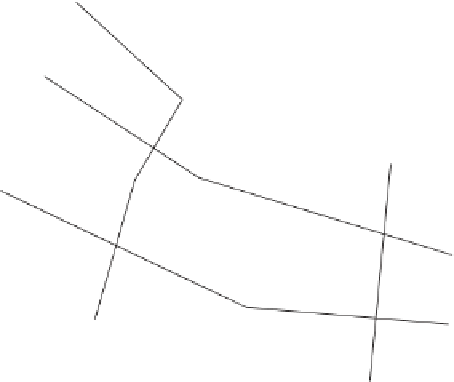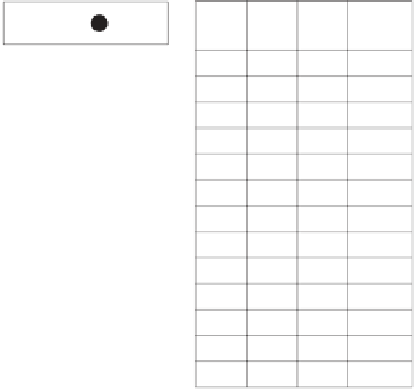Geography Reference
In-Depth Information
N1
A1
From
node
To
node
Node
Vertex
Arc
Length
N2
N3
1
2
3
4
5
6
7
8
9
10
11
12
13
1
3
2
5
4
4
6
7
7
8
8
10
10
3
4
4
7
7
8
8
9
10
10
11
12
13
1.358
0.529
1.230
0.665
2.335
0.991
1.204
0.674
0.797
2.588
0.728
0.687
0.598
A3
A2
N4
N5
N6
A5
A4
A6
A7
N7
N8
N9
A8
A9
A10
A11
N10
N12
A12
N11
A13
N13
Figure 6.1
Synthetic road network. Arc numbers are prefi xed by 'A' and node numbers by 'N'.
h e initial focus of this section is on simple summaries of networks, in terms of how
connected places are or how complex are the networks which connect these places.
Network connectivity
6.3
h e connectivity of a network can be represented using the connectivity matrix (Taafe
et al.
, 1996). h e connectivity matrix is a square matrix that contains the arc labels as
its column and row headings. h e matrix indicates those nodes that are connected by
an arc (assigned a value of 1) and those that are not (given 0). h e connectivity matrix
for the network shown in Figure 6.1 is given in Table 6.1. In this case, nodes 1 and 3,
for example, are connected by an arc—that is, the value for column 3 and row 1, or for
column 1 and row 3, is 1, indicating a connection.
h e matrix in Table 6.1 includes a i nal column that is the sum of all the row ele-
ments and it indicates the number of ways in which a node can be reached in one step
from other nodes. h e maximum number of possible ways (4) is for nodes 4, 7, 8,
and 10. h e connectivity matrix, indicated by
C
1
, in Table 6.1 refers to nodes that are
directly connected by arcs—it is termed 'i rst order. h is idea can be extended to the
case of nodes that are connected by two arcs with a further node in between—this is
termed 'second order' (and the matrix is indicated by
C
2
). h e matrix in the second-
order case is obtained by multiplying
C
1
with itself (given by
C
1
C
1
). Matrix multiplica-
tion is illustrated below, but further supporting material is given in Appendix A if
clarii cation is required. To multiply a matrix by itself the matrix is multiplied by
the transpose (as dei ned in Appendix A) of itself. Note that, in this case, the result of



















Search WWH ::

Custom Search